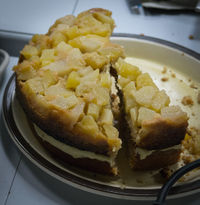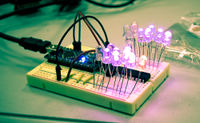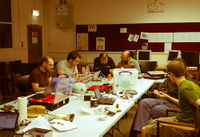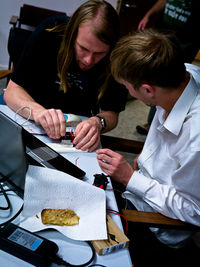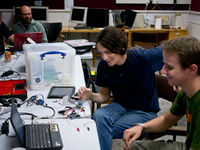Difference between revisions of "Arduino and Cake"
(→Sessions) |
(→Big Box of Breakout Boards and Bits (BBBBB)) |
||
| Line 26: | Line 26: | ||
We've had approval to buy some bits and pieces for people to play with at this event, and generally within Makespace so I've done an eBay dive and ordered the following, these will arrive sometime over the next month or so: | We've had approval to buy some bits and pieces for people to play with at this event, and generally within Makespace so I've done an eBay dive and ordered the following, these will arrive sometime over the next month or so: | ||
| − | # 80 high brightness LEDs (20 each of orange, green, blue and pink!) | + | # {{Done|80 high brightness LEDs (20 each of orange, green, blue and pink!)}} |
# 4 LED Dot matrix modules with drivers | # 4 LED Dot matrix modules with drivers | ||
# 2 Eight digit seven segment displays with drivers | # 2 Eight digit seven segment displays with drivers | ||
| Line 34: | Line 34: | ||
# 6 Arduino Nano v3 boards (ATMega328, mounts on a breadboard) | # 6 Arduino Nano v3 boards (ATMega328, mounts on a breadboard) | ||
# 12 Dual H-bridge modules, used to drive regular and stepper motors | # 12 Dual H-bridge modules, used to drive regular and stepper motors | ||
| − | # 3 Temperature / Relative humidity sensor modules | + | # {{Done|3 Temperature / Relative humidity sensor modules}} |
| − | # 2 IR correlation sensor modules (the kind where you have a beam which outputs a signal when broken, good for detecting rotation etc) | + | # {{Done|2 IR correlation sensor modules (the kind where you have a beam which outputs a signal when broken, good for detecting rotation etc)}} |
# 10 Small servo motors (9g plastic type) | # 10 Small servo motors (9g plastic type) | ||
# 6 Ultrasonic rangefinder modules, detect bounce from around 20cm to 3m | # 6 Ultrasonic rangefinder modules, detect bounce from around 20cm to 3m | ||
| − | # 4 Stepper motors with driver modules, 5v supply | + | # {{Done|4 Stepper motors with driver modules, 5v supply}} |
| − | # 1 Barometric pressure sensor module | + | # {{Done|1 Barometric pressure sensor module}} |
# 10 Playstation style joysticks, the little analogue ones with a built in pushbutton on breakout boards | # 10 Playstation style joysticks, the little analogue ones with a built in pushbutton on breakout boards | ||
| − | # 10 NRF24L01 radio modules, short (~100m) range radio modules capable of transmitting packets of 3 bytes at around 2Mbits/second under ideal conditions | + | # {{Done|10 NRF24L01 radio modules, short (~100m) range radio modules capable of transmitting packets of 3 bytes at around 2Mbits/second under ideal conditions}} |
# A lot of somewhat longer jumper leads (20cm and 30cm) both male to male and male to female, the latter being particularly useful for connecting to the radio modules as they have a non-breadboard-friendly pin layout (or we can make boards with the PCB mill) | # A lot of somewhat longer jumper leads (20cm and 30cm) both male to male and male to female, the latter being particularly useful for connecting to the radio modules as they have a non-breadboard-friendly pin layout (or we can make boards with the PCB mill) | ||
| Line 48: | Line 48: | ||
As and when these appear at my house I'll bring them in and add them to the BBBBB - I'm planning to buy a decent size box with compartments to keep these in, both as convenient access and as a way to monitor attrition (these are cheap, but the cheapness comes with long lead times). These bits will be for use at Makespace, rather than for consumption but as long as we have enough items we can be flexible on that; I think if someone has ordered a Nano, say, there's no reason we can't lend them one of the kit ones while they wait for it to turn up. | As and when these appear at my house I'll bring them in and add them to the BBBBB - I'm planning to buy a decent size box with compartments to keep these in, both as convenient access and as a way to monitor attrition (these are cheap, but the cheapness comes with long lead times). These bits will be for use at Makespace, rather than for consumption but as long as we have enough items we can be flexible on that; I think if someone has ordered a Nano, say, there's no reason we can't lend them one of the kit ones while they wait for it to turn up. | ||
| − | --[[User:Tomoinn|tmo]] | + | '''Update''' - we now have the box and some of the bits, I'm marking bits which have arrived and are now in the box in {{Done|this colour}} in the list above. At the moment the box is waiting to be documented and have the components properly marked, it'll then be left in Makespace and hopefully its contents won't evaporate too fast! |
| + | |||
| + | --[[User:Tomoinn|tmo]] 12:55, 9 August 2013 (BST) | ||
== Projects == | == Projects == | ||
Revision as of 11:55, 9 August 2013
Contents
Arduino and Cake
This is a page of information for the (hopefully) regular 'Arduino and Cake' event we run at Makespace. This is an evening where we get together in the space to learn and hack on projects involving the Arduino and similar microcontrollers. As the name suggests, there's also cake!
Sessions
We've had one session, with all levels of experience from complete novices to expert embedded programmers. Everyone paired up, with beginners and experts working together; judging from the happy buzz of making noises (both the noise of making, and the making of noises - we had buzzers!) it worked pretty well. The meetup page for the first go is on meetup here
The plan is to have this as regularly as possible, varying the day around in case people can't make a particular day of the week. The second one was on the 8th of August; meetup event here, big copies of the photos (which are lurking on the right hand side of this very page) here :) Some of the bits for the Big Box of Breakout Boards and Bits arrived, temperature and humidity sensors and stepper motor drivers yielded to sugar driven curiosity.
Next meeting will probably be Wednesday 14th, meetup link soon[tm]
Helpful links
Arduino home page : www.arduino.cc
A bunch of useful little circuits to play with: Arduino Basic Connections
Big Box of Breakout Boards and Bits (BBBBB)
We've had approval to buy some bits and pieces for people to play with at this event, and generally within Makespace so I've done an eBay dive and ordered the following, these will arrive sometime over the next month or so:
- 80 high brightness LEDs (20 each of orange, green, blue and pink!)
- 4 LED Dot matrix modules with drivers
- 2 Eight digit seven segment displays with drivers
- 2 Ethernet shields for the Arduino Nano
- 4 LCD 20x4 character displays
- 8 Motion sensors (6 degrees of freedom MPU6050 based with 3 axis gyro and 3 axis accelerometer)
- 6 Arduino Nano v3 boards (ATMega328, mounts on a breadboard)
- 12 Dual H-bridge modules, used to drive regular and stepper motors
- 3 Temperature / Relative humidity sensor modules
- 2 IR correlation sensor modules (the kind where you have a beam which outputs a signal when broken, good for detecting rotation etc)
- 10 Small servo motors (9g plastic type)
- 6 Ultrasonic rangefinder modules, detect bounce from around 20cm to 3m
- 4 Stepper motors with driver modules, 5v supply
- 1 Barometric pressure sensor module
- 10 Playstation style joysticks, the little analogue ones with a built in pushbutton on breakout boards
- 10 NRF24L01 radio modules, short (~100m) range radio modules capable of transmitting packets of 3 bytes at around 2Mbits/second under ideal conditions
- A lot of somewhat longer jumper leads (20cm and 30cm) both male to male and male to female, the latter being particularly useful for connecting to the radio modules as they have a non-breadboard-friendly pin layout (or we can make boards with the PCB mill)
Total budget for all the above including shipping is 270GBP (you get a lot of electronics for you money when buying from the far East!)
As and when these appear at my house I'll bring them in and add them to the BBBBB - I'm planning to buy a decent size box with compartments to keep these in, both as convenient access and as a way to monitor attrition (these are cheap, but the cheapness comes with long lead times). These bits will be for use at Makespace, rather than for consumption but as long as we have enough items we can be flexible on that; I think if someone has ordered a Nano, say, there's no reason we can't lend them one of the kit ones while they wait for it to turn up.
Update - we now have the box and some of the bits, I'm marking bits which have arrived and are now in the box in this colour in the list above. At the moment the box is waiting to be documented and have the components properly marked, it'll then be left in Makespace and hopefully its contents won't evaporate too fast!
--tmo 12:55, 9 August 2013 (BST)
Projects
Got an interesting project or a project idea? Add it here.
Vehicle monitor / heating controller
I've re-wired my Land Rover, using a star topology, with a big central "ganglion" which almost all the wires run to and from. There's an extra wire coming from each connection, that will go to a board of LEDs and voltage dividers, the latter feeding into an Arduino Mega, which will monitor just about everything, and display information on a small LCD panel.
I'm also planning to make a motorized heater control system (moving flaps to direct air from an Eberspacher) and the valve motors will be driven from relays on the Arduino.
And there'll be a GPS/GSM security unit, and eventually a Linux board (probably Pandaboard) running navigation software. And later on, I hope, an electric motor to drive the extra axle I added. The Arduino Mega will route data between all these points, with its multiple hardware UARTS, as well as sending out information it converts locally from its own inputs.
I expect the software will be a main loop that polls all UARTs for incoming information, all wiring lines for changes from their previous state, all heating valve position sensors for whether they've reached the right position, all pedals for information to send to the traction motor controller when fitted, and does the associated actions (for example, NMEA sentences from the GPS get forwarded to the Linux board for navigation and are also used to display the time on the LCD, heating switches update the desired positions for flap valves).
JCGS 15:00, 2 August 2013 (BST)
Quadcopter
Because everyone loves autonomous flying robots surrounded by razor sharp rotating propellers, right?
A friend and I are working on a full self build of a quad rotor, we have the airframe, motors, props, speed controllers and an arduino with a combined gyro / accelerometer mounted. We just need to add batteries, wireless comms and software. I don't know whether I can persuade Si to come along to this meeting, he's not a member, but that's one of the things I'm playing with at the moment. I'm using the MPU6050 and PID libraries to manage the feedback between the accelerometer and the speed controllers in an attempt to get a stable hover mode, and the NRF24L01 as the radio module.
--tmo 15:12, 2 August 2013 (BST)
Bottle rocket telemetry
The family makers are making bottle rockets, I thought it'd be cool to try to make a telemetry module that would tell them how high they'd gone and render a 3d trace of the trajectory using either Processing or WebGL. The main challenge here is to get the circuitry small enough and tough enough to be carried by the rockets and then survive the return to ground level! The second issue is power, I have a LiPo battery and charger so should just be a case of a 3.3v regulator but maybe it needs a boost converter, not really my area of expertise so I'd really like some help there.
At the moment I'm interested in using an ATTiny85 (8 pin dip package MCU) as an Arduino, using the MPU6050 gyro / accelerometer and an XBee v2 radio - I'd use the NRF24 radio but I think it needs more pins than I have available on the ATTiny. Another option would be to use a rather more sophisticated Arduino pro mini, more pins means the NRF radio would be an option which is much cheaper than the XBee modules.
--tmo 15:12, 2 August 2013 (BST)
I2C plant moisture sensors
Program an ATTiny85 as an I2C slave, embedding it onto a circuit board etched to work as a capacitive moisture sensor. Use Arduino nano with ethernet shield as an I2C master to then monitor the moisture levels in my various outdoor plant pots and tweet when they're getting too dry.
--tmo 15:12, 2 August 2013 (BST)
Breadboard prototype of a 1D Pong Game
The idea is to prototype a simple 1D pong game (see YouTube) on Arduino or other microcontroller.
Features:
- Some kind of startup animation (similar to the YouTube video)
- A scoreboard or something similar. Based maybe on a segmented display or LCD.
- SOUNDS! :-)
- Perhaps some different game modes, maybe "powerups" of some kind?
Eventually I would like this to be the start of a MUCH larger version of the game (but that's for the future ;-))
--DannyG 15:12, 2 August 2013 (BST)
